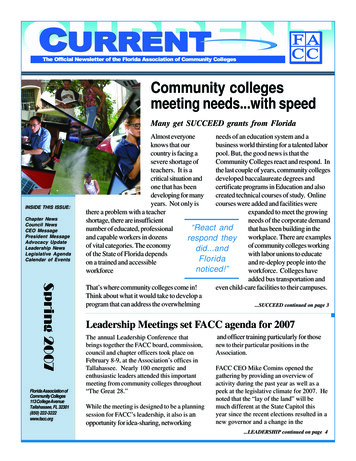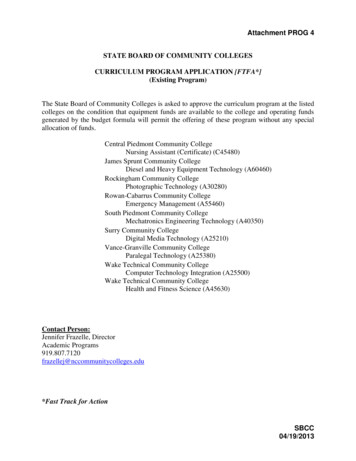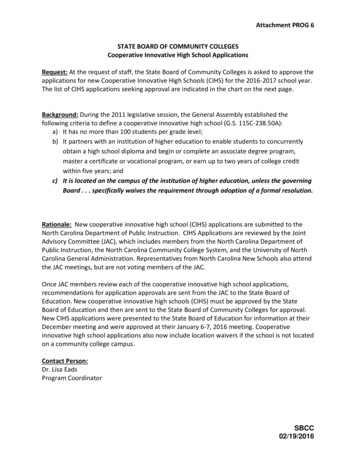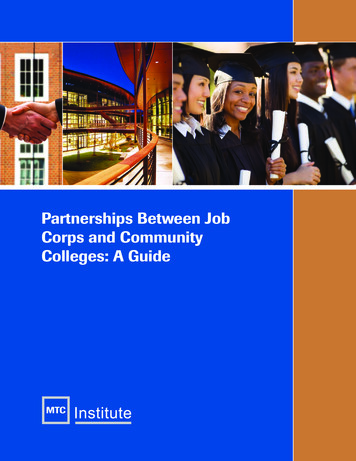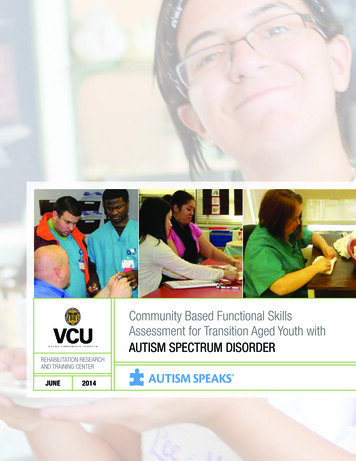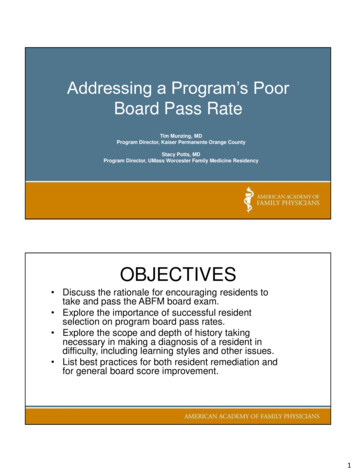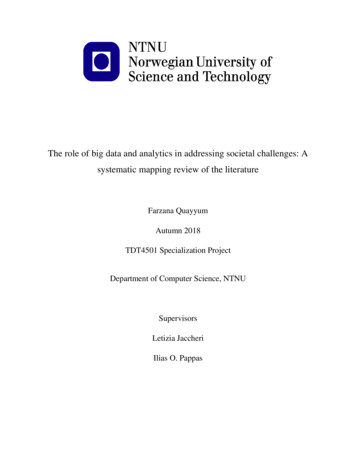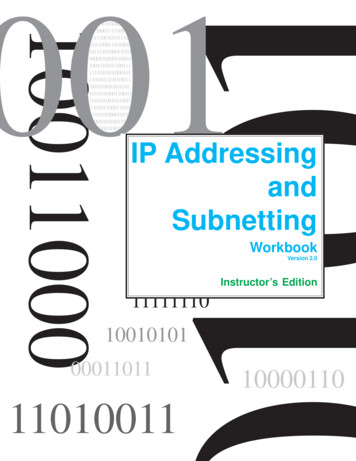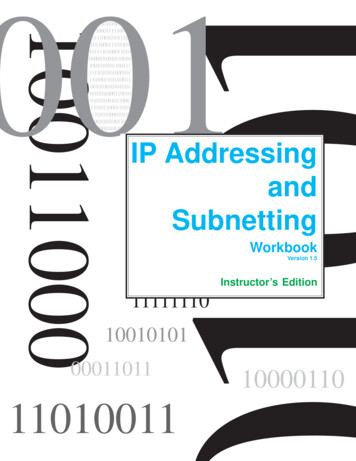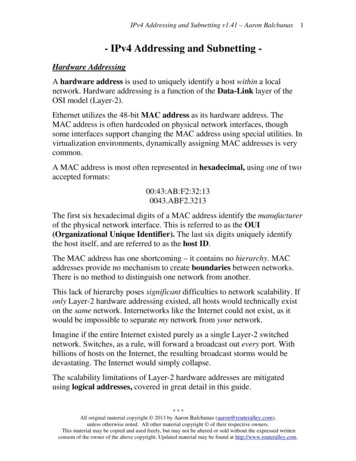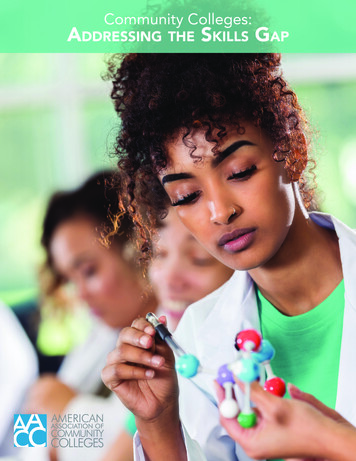
Transcription
Community Colleges:Addressing the Skills Gap
Community Colleges:Addressing the Skills GapContentsCommunity Colleges: Addressing the Skills Gap. 3A Brief Overview of Community College WorkforceDevelopment Programs. 3Federal Policy Issues and Key Programs. 4Other Important Programs. 6Community College Program ProfilesAlamo Colleges District. 8Arkansas State University – Newport. 9Cuyahoga Community College. 10Forsyth Technical Community College. 11Gateway Technical College. 12Kentucky Community and Technical CollegeSystem (KCTCS). 13Los Angeles Trade Technical College. 14Manchester Community College. 15Metropolitan Community College. 16Salt Lake Community College. 17South Seattle Community College. 18AMERICAN ASSOCIATION OF COMMUNITY COLLEGES2COMMUNITY COLLEGES: ADDRESSING THE SKILLS GAP
Community Colleges: Addressing the Skills GapHowever it is best described -- skills gap, skills mismatch or some other term – the current labor marketclearly exhibits an unprecedented and growing need for postsecondary workforce development. By thestart of the next decade, sixty-five percent of American jobs will require some postsecondary educationor training. Nearly half of those positions will require less than a baccalaureate degree and represent thefastest growing of all the job categories.The Department of Labor reported that, in July 2017, there were a record 6.2 million unfilled jobs. Whilenot all of them require postsecondary education, economists generally agree that one of the principalreasons for the growing number of vacant jobs is employers’ inability to find adequately trained workers.Employers large and small routinely lament that they cannot find enough qualified workers.Community colleges play an essential role in tackling this challenge. They are the first choice formillions of workers seeking to upgrade their skills, and for businesses looking for qualified applicants.Community colleges are geographically dispersed (the more than 1,100 institutions enroll 41% of allundergraduates), offer low tuition (average tuition and fees for a full-time student are 3,520), and areconsidered the most responsive sector of higher education in meeting the needs of the private sector.They are open-access institutions that take students as they come--from fully college-ready to thoselacking basic educational skills. Simultaneously, one of the fastest growing segments of communitycollege students are those that already have a postsecondary credential, frequently bachelor’s degrees.A Brief Overview of Community College Workforce Development ProgramsCommunity colleges have evolved from their early days as junior colleges that primarily provided thefirst two years of a four-year degree program. Now they are comprehensive institutions that offer awide array of courses, programs, and other services for people in all their career phases, as reflectedby the average student age of 28. Though in the truest sense we recognize that all higher educationconstitutes workforce education – studies repeatedly confirm that students primarily, if not exclusively,attend college for economic reasons – community college workforce programs are geared towardshelping students improve their employment status in the near- to medium-term, while providing longerterm career pathways.Community college workforce programs are extraordinarily varied and constantly evolving. Collegeofferings include traditional credit programs that award certificates and degrees ranging in length froma semester or less to two years or more. In the 2014-15 academic year, community colleges awarded807,000 degrees and 517,000 certificates. About 47 percent of the degrees were awarded in career andtechnical education (CTE) fields, while the vast majority of certificates (88%) were in CTE fields. Millionsof students are enrolled in non-credit training, which runs the gamut from one-day courses to fullfledged programs that resemble traditional for-credit programs. These programs often allow studentsto prepare for third-party credentials such as industry certifications, state licenses, and apprenticeshipcertificates. Historically, credit and non-credit community college programming is administered bydifferent institutional offices, but there is a growing effort to bridge that gap and create pathways intocredit-bearing programs for students starting in noncredit training programs.Blended non-credit/credit programs are just one example of an increasing emphasis among communityAMERICAN ASSOCIATION OF COMMUNITY COLLEGES3COMMUNITY COLLEGES: ADDRESSING THE SKILLS GAP
colleges at helping students progress more easily to employment and/or further education. Othercontinuing innovations include: stackable credentials, which allow students to earn multiple, industry-valued credentials whileprogressing towards a degree; guided pathways and career pathways, which help students navigate more efficiently towardstheir educational goals; co-requisite education, where students receive occupational and developmental educationsimultaneously, rather than in a sequence; and competency-based education and prior learning assessment, allowing students to progress attheir own pace based on what they have mastered.Partnerships with business are fundamental to the success of many community college workforcedevelopment programs. Local businesses sit on community college program advisory boards, ensuringthat program design provides workers with the needed education and skills. Businesses often tendermonetary support, equipment donations, and sometimes lend their employees to teach. Collegesdesign and deliver customized training programs for incumbent employees, often right at their worksites.Community college programs offer students opportunities for internships and other forms of workplacebased learning. They are also heavily involved in all phases of apprenticeships – from providing relatedclassroom instruction to sponsoring apprenticeship programs themselves.In order to establish and nurture a continuum of talent development, community colleges also workclosely with K-12 schools and four-year universities. Further, state and local economic development areentwined with community college workforce education efforts to help create the jobs of the future, inaddition to filling existing ones. Some of these efforts are realized through business incubators locatedon community college campuses, where fledging businesses are able to take advantage of collegeexpertise and infrastructure support.Many community college officials highly value their partnership with the workforce development systemauthorized by the Workforce Innovation and Opportunity Act (WIOA). College presidents and otherinstitutional leaders sit on local and state workforce development boards. One-stop career centers aresometimes located on college campuses, and, where they are not, college employees often work at thecenters. College programs are included on the eligible training provider lists for WIOA participants, andin other cases, colleges contract directly with local boards to deliver WIOA training.Federal Policy Issues and Key ProgramsA variety of federal programs help improve the scope and quality of community colleges’ workforcedevelopment programs. These programs are often criticized for being too numerous, or lacking acomprehensive approach, but each of them was established to address a particular need, and many ofthese needs remain. There is every likelihood that these particular needs would not be addressed withoutbeing targeted by these types of federal programs. Some of the more important aspects of these programsare described below.AMERICAN ASSOCIATION OF COMMUNITY COLLEGES4COMMUNITY COLLEGES: ADDRESSING THE SKILLS GAP
FundingFederal funding for workforce training programs has waned considerably with negative impacts toprograms. Compared to many industrialized nations, America devotes a smaller percentage of the grossdomestic product to educating its workforce.For example, when inflation is taken into account, appropriations for the core WIOA programs declined39% between FY 2001 and 2017. Not surprisingly, fewer individuals are now receiving WIOA training.Perkins Career and Technical Act (Perkins Act) state grants support the improvement of high school andpostsecondary CTE programs, and the Adult Education and Family Literacy Act programs educate adultswith less than a high school education. There too, funding has been on the decline. Community collegeswill continue to advocate for stronger support from the federal government in these areas.There is currently no federal program that directly supports expanding community college training. Thiswas previously effected through the Trade Adjustment Assistance Community College and Career Training(TAACCCT) program and, before that, the Community-Based Job Training Grants (CBJTG) that waschampioned by former President George W. Bush. Both of these programs were invaluable to communitycollege efforts to train more people in ever-more innovative ways, with strong accountability features.Community colleges continue to urge Congress to enact a program drawn along these lines to build onthis progress.Fixing Problematic Accountability Measures: The Higher Education Act (HEA) and Perkins Act containmetrics largely focused on completion. The widely adopted state performance-based funding frameworksalso emphasize completion. However, while completion is a fundamental goal that remains an ongoingpriority, the reality is that many community college students achieve their educational goals withoutreceiving an academic credential. Often, students only need to take one or a few classes to get a promotionor otherwise progress in their careers. There are growing efforts to quantify these so-called “skill builders”in California and elsewhere. In the meantime, federal accountability metrics need to be refined to reflectthese successes. AACC continues to believe that the federal government should create a unit recorddata system linked to Department of Treasury wage data that enables students and the broader public toknow more about the benefits of completing a particular postsecondary program—for all postsecondaryeducation programs.Better-Calibrated Student Support: The bulk of federal support for undergraduate higher educationcomes through the HEA’s Title IV programs. Other important sources of support are veterans’ benefits andthe tax code’s American Opportunity Tax Credit (AOTC) and Lifetime Learning Credit.Although not labeled as such, the largest federal workforce education program is the Pell Grant Program.Thirty-eight percent, some 2.4 million, of all community college students receive Pell Grants. Many areenrolled in workforce programs. However, the program is still partially tilted towards traditional collegestudents, and it should be changed to better assist working students focused on career development.In particular, financially needy students in highly effective short-term programs should be eligible for PellGrants. Currently, programs shorter than two-thirds of a year do not qualify. Also, more community collegestudents need to be better informed about the array of student aid benefits and able to more easily accessthem.AMERICAN ASSOCIATION OF COMMUNITY COLLEGES5COMMUNITY COLLEGES: ADDRESSING THE SKILLS GAP
The tax code is a substantial source of support for postsecondary students. The AOTC provides up to 2,500 a year for eligible students. However, it should be modified to ensure that community collegestudents receiving Pell Grants can qualify for the credit. In addition, the Lifetime Learning Credit shouldbe modified so that community college students receive more assistance. Currently, students must spend 10,000 on tuition and fees to maximize the credit, so graduate and professional students attendingmore expensive institutions receive the full 2,000 credit while workers looking to enhance their skills atcommunity colleges receive relatively little—just 20% of any tuition that they pay. For many workforceprograms, this is a small amount.Increased Program Alignment: Changes made in the WIOA reauthorization provided much-neededprogram alignment, particularly by uniformly applying accountability measures, which are more gearedtowards worker attainment of postsecondary credentials. House-passed legislation to reauthorize thePerkins Act, the Strengthening Career and Technical Education for the 21st Century Act (H.R. 2353),would make further progress towards alignment of Perkins and WIOA, including very similar accountabilitymeasures. Draft Senate legislation circulated last year took a similar approach, but has not been formallyintroduced. It would be highly desirable for the Perkins statute to be crafted in relation to the WIOAaccountability measures.Other Important ProgramsIn addition, the following programs are also important sources of support for community college workforcedevelopment:Advanced Technological Education (ATE): The ATE program is the principal community college-focusedprogram at the National Science Foundation. It funds national and regional centers and college levelprograms aimed at growing the sub-baccalaureate STEM workforce. Over its 25-year existence, the programhas expanded steadily and is a beacon of community college program improvement, demonstrating thepositive impact of thoughtfully conceived federal support.Supplemental Nutrition Assistance Program Employment and Training: This program, administeredby the Food and Nutrition Services division of the Department of Agriculture, allows states to provideemployment and training services to SNAP (formerly known as food stamps) recipients. It has been usedsuccessfully to provide needed resources for students looking to improve skills in workforce trainingprograms.DOL Apprenticeship Grants and Registered Apprenticeship College Consortium (RACC): The DOL’sapprenticeship grants have greatly broadened the reach of apprenticeship programs. Administered byDOL’s Office of Apprenticeship, the RACC facilitates the conversion of the skills gained in apprenticeshipsinto college credit, making it easier for apprentices to pursue further education. AACC supports this andany related efforts to expand apprenticeships, both in number and focus, particularly in “new collar” fieldsopen to populations not traditionally engaged in apprenticeship programs.AMERICAN ASSOCIATION OF COMMUNITY COLLEGES6COMMUNITY COLLEGES: ADDRESSING THE SKILLS GAP
Community College Program ProfilesThe community college workforce developmentprograms described in the following pages areemblematic of thousands of similarly successfulprograms at the nation’s community colleges. Theyare located at urban and rural colleges alike, andserve varied student populations. These programsprovide concrete examples of the different kindsof success that can be achieved when communitycolleges, industry partners, local communities,and the federal government work to strengthenprograms and services aimed at ensuring Americansare prepared for quality jobs.AMERICAN ASSOCIATION OF COMMUNITY COLLEGES7COMMUNITY COLLEGES: ADDRESSING THE SKILLS GAP
Alamo Colleges DistrictSan Antonio, TX Alamo AcademiesProgram Description: The Alamo Colleges, comprised of 5 community colleges in the San Antonio area,is a lead partner in the Alamo Academies, along with business, local high schools, and municipalities.The Academies provide high school juniors and seniors with tuition-free career pathways into criticaldemand technical STEM occupations. The Academies supply the region with high-tech, high-skilledtalent by developing a pipeline of college educated technicians to staff new jobs and replace a retiringworkforce in targeted industry clusters. 86% of the students are economically disadvantaged and 70%are Hispanic. The academies enroll 400 students each year.Students attain industry and academic certificates leading to high-wage jobs or further highereducation while addressing critical workforce industry needs. The program focuses on five occupationalareas: aerospace, advanced manufacturing, information technology and security, nursing, and heavyequipment. Students are transported to an Alamo Colleges campus daily where they engage in2 ½ hours of contextual learning. During the two-year program of studies, students earn more than30 college credits with courses articulating to an Associate of Applied Science (AAS) degree at nopersonal cost. Upon graduation, students can either enter a high-wage career in a demand occupationor continue their higher education pathway. As part of the program of studies, students participate in apaid internship during the summer between their junior and senior year, applying the knowledge andskills learned while earning approximately 3,000 and college credit. Each partner provides uniquecontributions: employers mentor, provide valuable work experience and pay their intern’s salaries; AlamoColleges provide facilities, equipment and instruction; school districts provide textbooks and round triptransportation; and municipalities fund operating costs. Industry partners include Toyota, Valero, MartinMarietta, University Health System and several others.Outcomes: To date, more than 1,400 students have graduated from the Alamo Academies, earning3,132 industry certificates. 95% of program graduates attain employment or pursue higher education.Impact of Federal Programs: When the Academies board receives a request from an industry clusterto implement a new Academy or modify existing Academy curricula, the local workforce board is a keypartner in identifying and verifying workforce needs and requirements. The colleges use Perkins Actfunds to purchase equipment that is utilized by the Alamo Academies programs.AMERICAN ASSOCIATION OF COMMUNITY COLLEGES8COMMUNITY COLLEGES: ADDRESSING THE SKILLS GAP
Arkansas State University – NewportNewport, AR Commercial Truck DrivingProgram Description: Professional truck drivers are always in high demand, and ASUN offers a programof study designed to prepare students for a rewarding career in commercial truck driving. Arkansas isa nationwide logistics hub, with expanding opportunities for professional drivers. The program is trulya public-private partnership. The Newport Economic Development Council (NEDC) bought housingin Newport to support the partnership with Maverick, the lead industry partner. Maverick pays NEDCrent for the housing of their students while they’re enrolled in the program. Students earn a Certificateof Proficiency and a Class A Commercial Driver’s License upon successful completion of the program.Program completers have been hired by employers like MC Express, Maverick, Walmart, Werner, PAM,ABF, JB Hunt and many regional transportation companies. Starting pay for these positions is over 50,000 per year with benefits. Over 95% of the program’s students are sponsored by an employer thatguarantees employment upon successful completion of the program.Outcomes: The program awarded 184 certificates in the 2016-17 academic year. 95% of programenrollees complete the program.Impact of Federal Programs: The program is too short in length to be Pell Grant eligible, and thereforeis an example of the type of program that would benefit from expanded Pell Grant eligibility to shortterm programs serving a demonst
college students are those that already have a postsecondary credential, frequently bachelor’s degrees. . offerings include traditional credit programs that award certificates and degrees ranging in length from a semester or less to two years or more.

